
The interview with Ms. Lyu Yue (Aluna) took place at a café in 751D·PARK, in the adjoining fashion corridor, “Beyond Seeing: From the Brother Cup to Hempel Award”: China International Young Fashion Designers Contest 30 Years 1993-2022 which was the latest exhibition on display curated by her. In 1993 following the establishment of CHIC, China International Young Fashion Designers Contest was founded. Over the past 30 years, the Contest has cultivated a group of leading figures and outstanding clothing designers for the Chinese clothing industry. In Lyu Yue’s words, it is “a competition with the most influential power, the highest success rate and the highest attention in our industry.” The exhibition presents a microcosm of the 30-year development and changes in China’s fashion industry with more than 60 award-winning works, documents and historical video materials from the Contest over the past 30 years [1].


Exhibition View of “Beyond Seeing: From the Brother Cup to Hempel Award”
Among the many exhibitions curated by Lyu Yue, “Beyond Seeing” has a special significance. She believes that she can curate such an important documentary exhibition on the 30th anniversary of the China International Young Fashion Designers Contest, “which will be regarded as a recognition of the great influence of CAFA fashion design discipline and CAFA teachers in the academia circle and fashion industry.” When we look back at her resume, we find that her achievements also developed with the Chinese fashion industry.
Lyu Yue’s bond with clothing was earlier than we thought. When she was 4 years old, she began to embellish buttons of various colors on her clothes. When she was enrolled in the High School Affiliated to the Central Academy of Fine Arts, she was fiddling with the sewing machine in the lounge of the cafeteria, making clothes by herself, while other students were concentrating on drawing, and she especially liked to look at the pictures of clothes in foreign periodicals. In 1984, Lyu Yue graduated from the High School Affiliated to the Central Academy of Fine Arts. This is when the Central Academy of Arts and Crafts established the first Department of Textile and Fashion Design in the country. Her classmates (Liu Xiaodong, Yu Hong, Zhao Bandi, etc.) all went to the Central Academy of Fine Arts to study painting. Lyu Yue chose to listen to her inner voice and embarked on this profession that was brand new to many people at that time. In 1988, she stayed at the Central Academy of Arts and Crafts to teach after graduation, when China’s clothing industry just started.
1993 was the “first year” that Lyu Yue regarded as the start of fashion design in China, which needs to be discussed and proved as many major events related to the fashion industry occurred. In the same year, after watching several foreign fashion shows at CHIC, Lyu Yue was deeply shocked and she quit her job the following year to practice her own development in a fashion company. At that time, Lyu Yue was still a new star in the industry. She began to bring her designs to participate in CHIC after she accumulated her experience in the company, and won the gold award for design in 1996, 1997, 1998 and the “Three Consecutive Championships” award. She was also awarded as one of the “Top Ten Fashion Designers in China” established by the CHIC. In 1996, her solo haute couture show was presented at the Beijing International Hotel. In March 1997, she held a solo couture show at the Diaoyutai State Guesthouse in Beijing. In December of 1997, she participated in the first China International Fashion Fair (the predecessor of China International Fashion Week) and won the title of “Golden List Designer.”

The Curtain Call of the Solo Couture Show during the 1996 CHIC (China International Fashion Fair) at the Diaoyutai State Guest House

In 1997, she successively won the titles of one of the “Top Ten Fashion Designers in China” and “Golden List Designer.”

In September 2002, Pan Gongkai, Sun Weimin, Zhang Baowei, Tan Ping, Ma Gang, Lyu Yue and others attended the unveiling ceremony of the School of Design at CAFA.
Lyu Yue was already a mother when she was invited by the Central Academy of Fine Arts to work there. She accepted the invitation from CAFA to set up a fashion design major partly due to the fact that she wanted to spend more time with her child, but Lyu Yue also believed that this was also “fate”. As a professional designer in a company for ten years, she experienced the shareholding reform of Chinese companies from foreign companies to state-owned companies, and has been a design consultant for different companies. Lyu Yue has achieved good results as well as a comprehensive understanding of the development of the entire industry while also being occupied with her job and she further has a deeper understanding of herself. She believes that in the fast-selling industry of clothing, only with a brand awareness can she be more competitive. Only when a piece of clothing achieves a balance between artistry and functionality, can it have a multiplied added value. What she can do is not to set up a brand and do sales by herself, but to conduct clothing design and provide clothing guidance with a more social value.



The Pictures of the 2006 Undergraduate Graduation (the first session of graduates from Fashion Design Major) Work Release & Graduation Exhibition
The establishment of a Discipline in Fashion Design was nothing new to other domestic colleges at that time. But for a school that said goodbye to the pattern department (the predecessor to design) in the 1950s, starting such a discipline was no easy task. Lyu Yue needed to think about professional positioning and build a team. In terms of professional positioning, she combined the characteristics of the Central Academy of Fine Arts and made use of her practical work experience to create a new positioning. The so-called “new” characteristic was that it was different from other colleges. The Fashion Design Discipline of the Central Academy of Fine Arts was named accordingly and it aimed to cultivate students’ ability in brand design, at the same time, students are required to be able to form complex designs and master the laws of formal beauty. Recalling the past 20 years, Lyu Yue feels as if it was just yesterday.
Before returning to teach at CAFA, Lyu Yue’s daily routine was watching shows, or visiting factories for fabrics. When she came to work at the Central Academy of Fine Arts, she originally planned to spend more time with her family, but she couldn’t take care of her child at all for there were more than 1,000 hours of classes in a semester. As a woman, when asked how to balance her work and family, Lyu Yue did not shy away from her debt to her son. However, she is satisfied that “she did not have to travel frequently, at least she can pick up her son from school on weekends.”
Lyu Yue led a jet-set life when she was young and she didn’t live at home. Currently Lyu Yue is both a mother and a daughter. At the end of the interview, she talked about her mother and hoped that she offer her company. As for her son who has his own space now, she feels very comfortable seeing and caring for him occasionally.
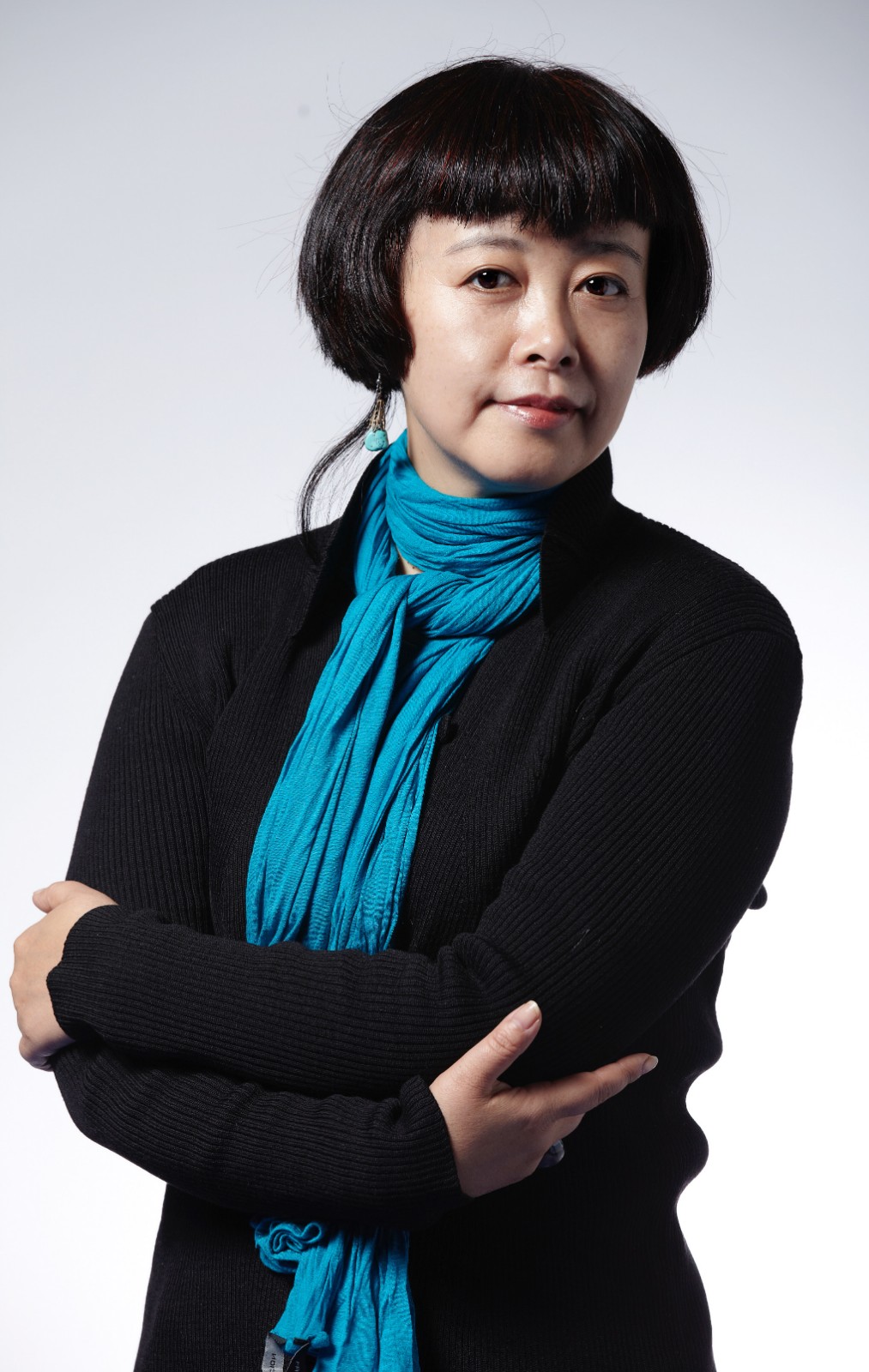
Portrait of Lyu Yue
Second-level Professor of the Central Academy of Fine Arts, Discipline Leader, Founder of Fashion Design and Doctoral Supervisor
It’s Beyond Seeing, and It’s More than Wearing
CAFA ART INFO: Would you introduce the China International Young Fashion Designers Contest from the very beginning? What’s your relationship with the Contest?
Lyu Yue: First of all, the platform of this competition is a stage where fashion designers have emerged and attracted much attention, and the proportion of “emerging designers” who became known from this stage and then went on to became the leaders of China’s fashion design industry in the future was pretty high. In 1993, the Contest was established with the creation of the China International Fashion Fair (CHIC). At that time, China’s clothing industry had just started, in addition to the establishment of CHIC and the Contest, Valentino, then Dior’s chief fashion designer Gianfranco Ferre, Pierre Cardin and other internationally renowned fashion designers came to China to hold their couture shows, and they were received by the top leaders of the country at that time. With the development of the China International Young Fashion Designers Contest, it has become the most influential competition in our industry with the highest completion rate and the highest attention. Designers who won gold and silver awards in contests have since grown into leaders in the industry and well-known designers. For example, the previous gold medalists Wu Haiyan, Ma Ke, Wu Xuewei and Wu Xuekai brothers. It can be said that this Contest is the most important competition in the Chinese fashion industry, with high requirements for creativity, and is a competitive platform for ideas, technology and ability.
My relationship with the Contest can be dated back to my college days. From 1987 to 1988, when I was still a student at the Central Academy of Arts and Crafts, I participated in the International Young Designers Competition held in Paris, which was sponsored by institutions such as Air France and Brother Industries, Ltd (Japan), where young designers from all over the world participated. Later, when I graduated and stayed in school to become a teacher at the Central Academy of Arts and Crafts, in 1993, I took the students’ works to Paris to participate in this competition. In the same year, when the CHIC was first established in China, I also saw several couture shows by famous French and Italian designers, and I was deeply impressed. After that, I left school to work as the chief fashion designer in a clothing company, and after accumulating several years of experience, I began to participate in CHIC with the brand in 1996, and won the 96, 97, 98 three years design gold award and the “Three Consecutive Championships” award. I personally participated in the “China’s Top Ten Fashion Designers” set up by CHIC and was praised. It can be said that my personal experience and the contests are almost synchronized. It is precisely because of the Contest that more young people majoring in fashion design have been paid attention to and have begun to show their talent, and the teachers and students from colleges have become more and more valued, laying the foundation for the School of Design at the Central Academy of Fine Arts.
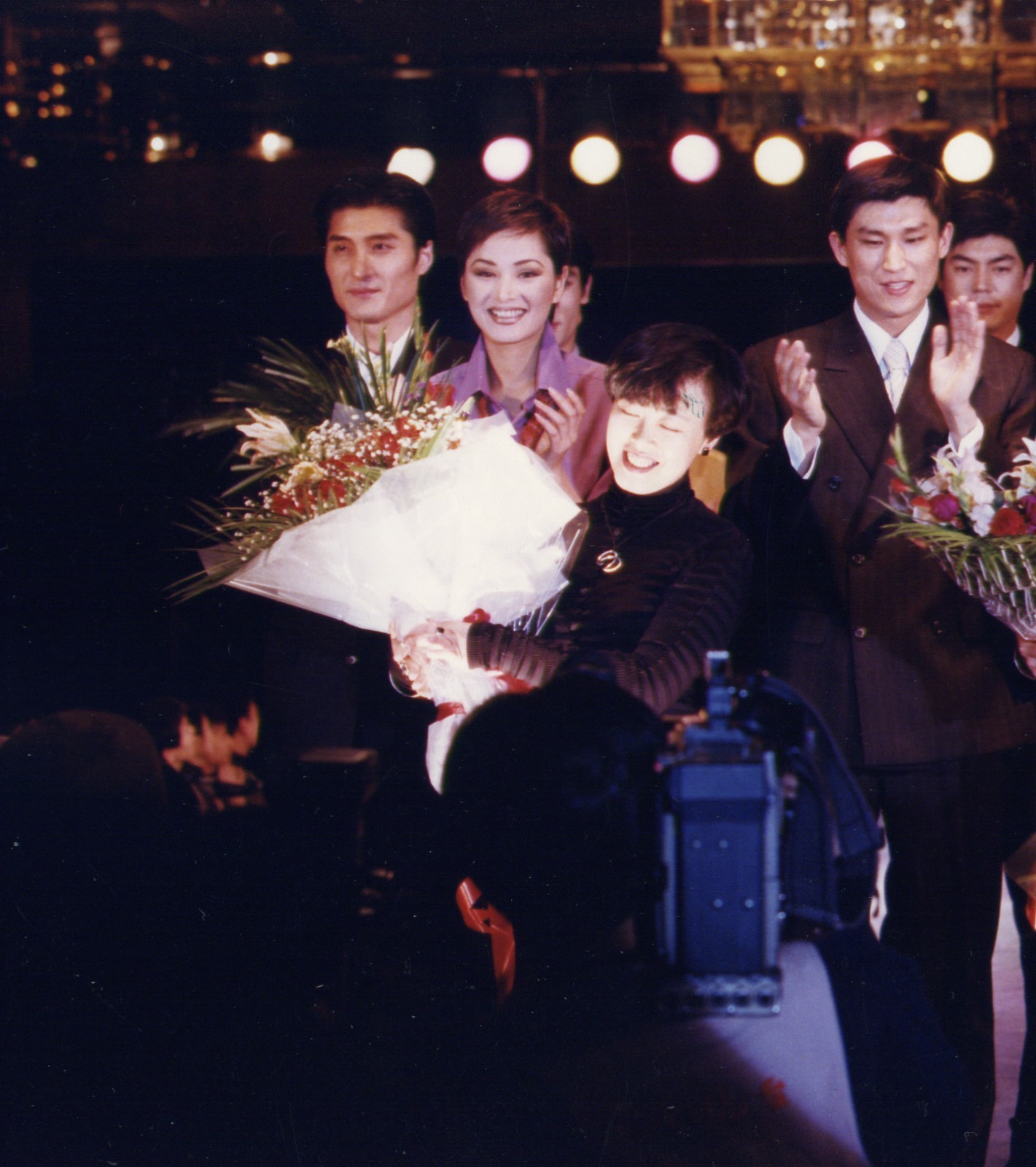
In December 1997, the first CHIC Men’s Wear Couture Show ended.
 In 1997, the China Fashion Designers Association established the Fashion Art Committee, and the first committee members consisted of ten well-known Chinese fashion designers, the middle of which was Mr. Du Yuzhou, who was the chairman of the China Fashion Designers Association at the time.
In 1997, the China Fashion Designers Association established the Fashion Art Committee, and the first committee members consisted of ten well-known Chinese fashion designers, the middle of which was Mr. Du Yuzhou, who was the chairman of the China Fashion Designers Association at the time.
CAFA ART INFO: “From Brother Cup to Hempel Award”, are there any changes in the Contest? Would you explain the title of this exhibition?
Lyu Yue: Brother Industries, Ltd. sponsored the contests for ten years, after which the Hempel Group took over and named it the Hempel Award. “From Brother Cup to Hempel Award”, the sponsor has changed but in fact, there is also an epochal change in the process. The first is the development of the economy, the ability of Chinese brands has increased, the living standards of the people have improved, and the design environment has changed; With the development of science and technology, new technologies such as digital printing and 3D printing have been applied to the field of clothing design; The other is the change in the status of the contestants, many of whom have been young people who have gone to work in the past. With the development of the times, the clothing departments of domestic colleges and universities have sprung up, and the student group has become a new force and an active participant. In recent years, due to the influence of the pandemic, the jury has lost the attendance of some international judges, and some foreign participants can only regrettably defend themselves through video calls, and many aspects are changing with time and environment.
The theme of the exhibition, “Beyond Seeing”, is intended to convey a new perspective from the narrative structure of the exhibits, that is, “fashion is beyond seeing”, followed by a sentence “more than wearing”. This leaves enough room for discussion today when we think about the dialectical relationship between fashion and socio-economy, scientific and technological inventions, literary works, music creation, communication methods, and even thinking about design boundaries. “Beyond Seeing” means a lot and it prompts the viewer to think about the power and value behind watching.


Exhibition View of “Beyond Seeing: From the Brother Cup to Hempel Award”
CAFA ART INFO: You have curated many fashion art exhibitions, what kind of opportunity made you start curating exhibitions?
Lyu Yue: After working at the Central Academy of Fine Arts, I withdrew from the role of fashion designer, completed basic research in fashion art in addition to teaching, and had some of my own fashion art works, and began to be invited to participate in international fashion art exhibitions. However, I found that too few Chinese artists go abroad to exhibit, and there were almost no Chinese counterparts to meet. I am the kind of person who likes to call my friends to do things together, and I try to recommend other fashion art works by Chinese designers in the same way, but I was blocked for a simple reason: international exhibitions have their own requirements for each country. So the idea of holding an exhibition in China was born. In 2007, with the support of the Beijing Fashion Design and Textile Industry Association and the help of Professor Key-Sook Geum, who was the former dean of the Graduate School of Hongik University in South Korea and came to China to study, a Sino-Korean exchange exhibition was completed in the exhibition hall of the Korean Cultural Center affiliated to the Korean Embassy. With the help of the 2008 Beijing Olympics and my identity then as President of the Beijing Fashion Designers Branch Association and the assistance of the Korea Fashion Art Association, Professor Key-Sook Geum and I co-curated it, and our teachers and students of CAFA Fashion Design helped organize the international exhibition with 87 artists from nine countries (China, France, South Korea, the United Kingdom, Israel, Austria, Germany, Poland, and the United States). This year, the 15-year-old exhibition has selected 135 artists to participate in it, which is becoming increasingly influential.



Exhibition View of “Beyond Seeing: From the Brother Cup to Hempel Award”
CAFA ART INFO: It is difficult to sort through the literature and works of the past 30 years for the Contests. Can you tell us about your specific plans for this exhibition? It is often said that people do not reach adulthood until they are 30 years old, in your opinion, what does the 30th anniversary of the Contest mean?
Lyu Yue: This exhibition is mainly a documentary exhibition, and a lot of literature sorting work needs to be done. In the past, the exhibition was a bit like recruitment, the exhibition theme came out and we collected works from artists, and after everyone submitted their work, we selected. This exhibition was curated by me and another curator, Yang Xiaohan, who graduated from the Department of Fashion Design, CAFA and later studied for a doctorate in curation at CAFA, and she is now a young teacher at Beijing Institute of Fashion Technology. With the assistance of the curatorial team of the Industry Center of the China Fashion Designers Association, we led the CAFA fashion teachers and students to work together to sort out the materials preserved in history and add some academic content. For example, the “simultaneity” that can be seen in the exhibition of each year’s award-winning works is not only the clothes and design descriptions, but also the context at that time, revealing the epochal development and change. Another part of the work is the collection of historical materials, organizing these historical documents according to a certain context.

The Curatorial Team of “Beyond Seeing”, from the left: Qin Geng, Liu Xin, Zheng Yonghe, Bao Yiwen, Yang Xiaohan, Lyu Yue, Liu Xiao, He Ran, Cai Jiapeng, Luo Jie.
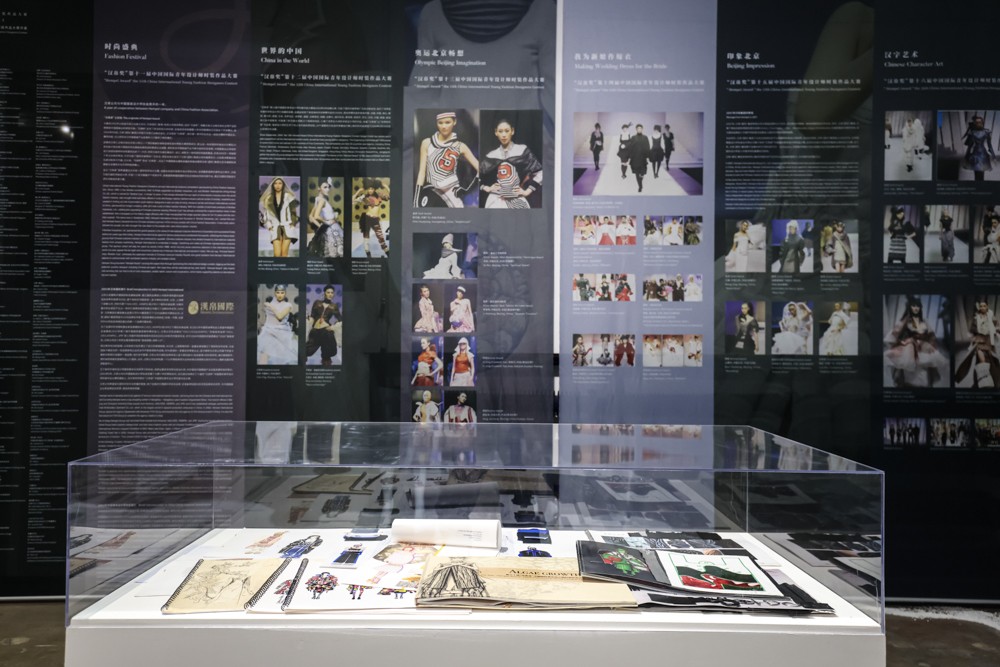


Exhibition View of “Beyond Seeing: From the Brother Cup to Hempel Award”
Cultivating Students to Build Their Own Language System
CAFA ART INFO: How did you feel from participating in the competition to taking students to the competition? How did students from CAFA perform in the competition?
Lyu Yue: Sometimes I joked that I was not a contestant, so I did not participate in too many competitions during my life, and I often cannot take care of things other than design when I am busy. When I returned to CAFA as a teacher, my perception changed, and I encouraged my students to participate because I felt that this was a way for young people to emerge and is more conducive to their growth. Our generation is easy to be seen, since there were only a few brands that did well. There are too many brands now, and it is difficult for young people to be discovered if they do not have a path. Sometimes I also guide students to choose their entries.
CAFA students have achieved good results in different fashion art competitions. Compared with the students of other colleges, our students are very individualized. Because we emphasize the expression of students’ personality in teaching, students’ creations also pay more attention to artistic presentation, and they will learn from contemporary art techniques such as installation, concepts, and performances while working on design, showing a diversified appearance. During my teaching, I also strongly encourage students to avoid what others have already done, to explore and express themselves, and to establish their own language system. This includes confidence and understanding of themselves.

The Preliminary Evaluation for “Hempel Award” in 2009
The Preliminary Evaluation for “Hempel Award” in 2022
The Group Photo of Jury Members of Final Evaluation for “Hempel Award” in 2021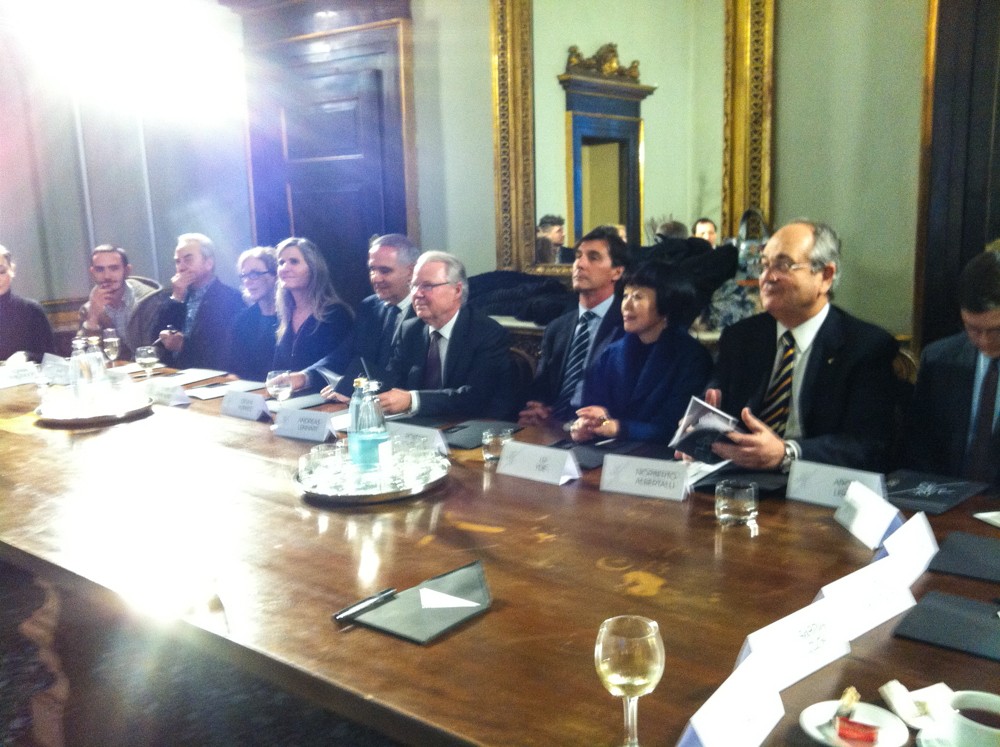
Lyu Yue served as the only jury member from Asia in 2012 and 2013 and attended the “REMIX” in Milan, Italy.
CAFA ART INFO: The fashion design major at CAFA is a relatively new major, as the founder of this major, please talk about its position at CAFA or even in the School of Design, and its current development?
Lyu Yue: After the founding of the People’s Republic of China, the Pattern Department (Department of Applied Fine Arts) of the Central Academy of Fine Arts was allocated to establish the Central Academy of Arts and Crafts, which was merged into the Academy of Arts & Design, Tsinghua University in 2000 to become a second-level college. At that time, it increased its efforts to supplement the art discipline, and the Central Academy of Fine Arts began to supplement the teachers and teaching strength of the design discipline. I returned to the Central Academy of Fine Arts on this occasion and became the founder of the later fashion design discipline. When it was founded in 2002, many domestic colleges and universities already had clothing departments. How to position this discipline was the first question I thought about.
Before returning to CAFA, I worked as a professional designer in the business for ten years. In these jobs, I have accumulated experience in the front line of design and brought it to the creation of a profession. In addition, I received artistic training in the High School Affiliated to CAFA and I am very familiar with the differences between CAFA and other colleges and universities, because I stayed in the Central Academy of Arts and Crafts for six years after I graduated, and I have a certain understanding of teaching. With the changes of the epoch, the influence of domestic fashion brands is getting better and better, and my idea at that time was that we must have the new positioning of the Central Academy of Fine Arts in combination with the needs of society, after a lot of academic sorting and discussion, and we held teaching seminars with leaders and teachers. The final major is called “fashion design” and last year it was rated as a first-class discipline.

She chaired a workshop at Harvard University in 2016.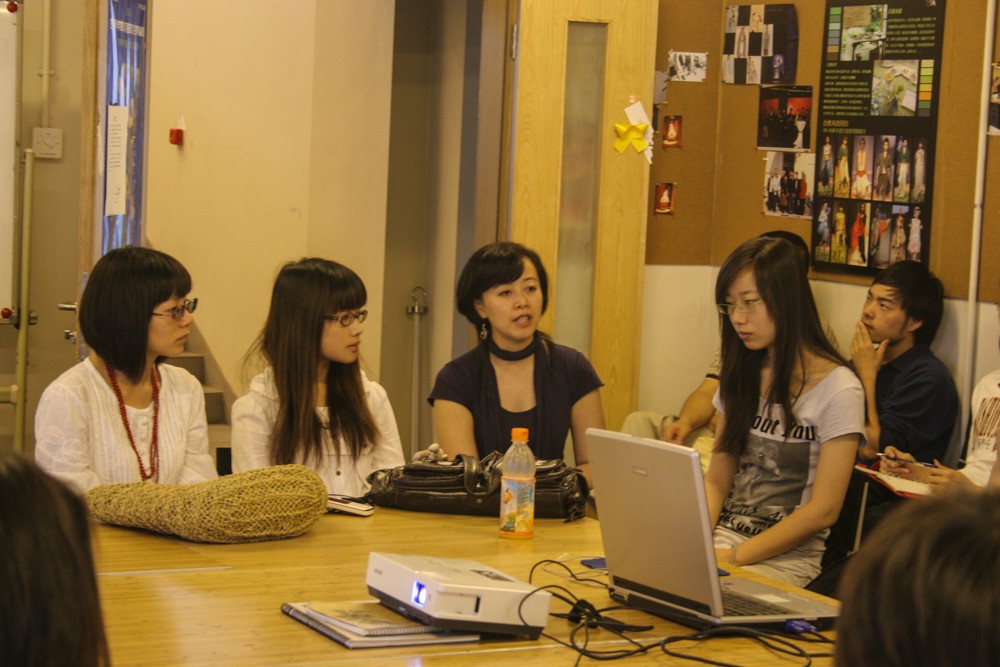
She taught at the Fashion Design Studio, Room 520, Building 7, CAFA in 2008.
She gave a lecture at New York College, Kent State University.
From the perspective of the entire design discipline, fashion is a very large category, and after the expansion of the concept of fashion design and fashion, it increasingly affects all aspects of life. When we first started, there were three people in our team, and the teachers mainly relied on hiring experts, and now we have several young teachers in our studio. The teachers of post-90s generation will apply their perception of new technologies such as meta-universe, AI technology, digital fashion, and NFT to their own courses and even personal creations, which is very inspiring for students. The virtual graduate Yuanlai, who appeared at this year’s graduate graduation exhibition, witnessed a transformation of our discipline. The Fashion design discipline needs to broaden the boundary, keep up with the development of the times, and the combination of cutting-edge technology, the core is what fashion can do, what else can be done? This is also a core underlying logic of fashion designers or fashion art creators.
“What remains unchanged is a change”
CAFA ART INFO: Many of today’s fashion designs do not seem to be designed for wearing. There is a big gap with the lives of ordinary people, especially the design by the students from the Central Academy of Fine Arts, which is more artistic and more difficult to understand. What do you think about this question?
Lyu Yue: I used to have the same question. I began to think about this question when I entered the fashion design industry as a professional designer in the 1990s. There were so many works on the catwalk that can’t be worn, why was everyone applauding? Sorting out and figuring out this problem came after I returned to work at the Central Academy of Fine Arts in 2005. It took more than a decade.


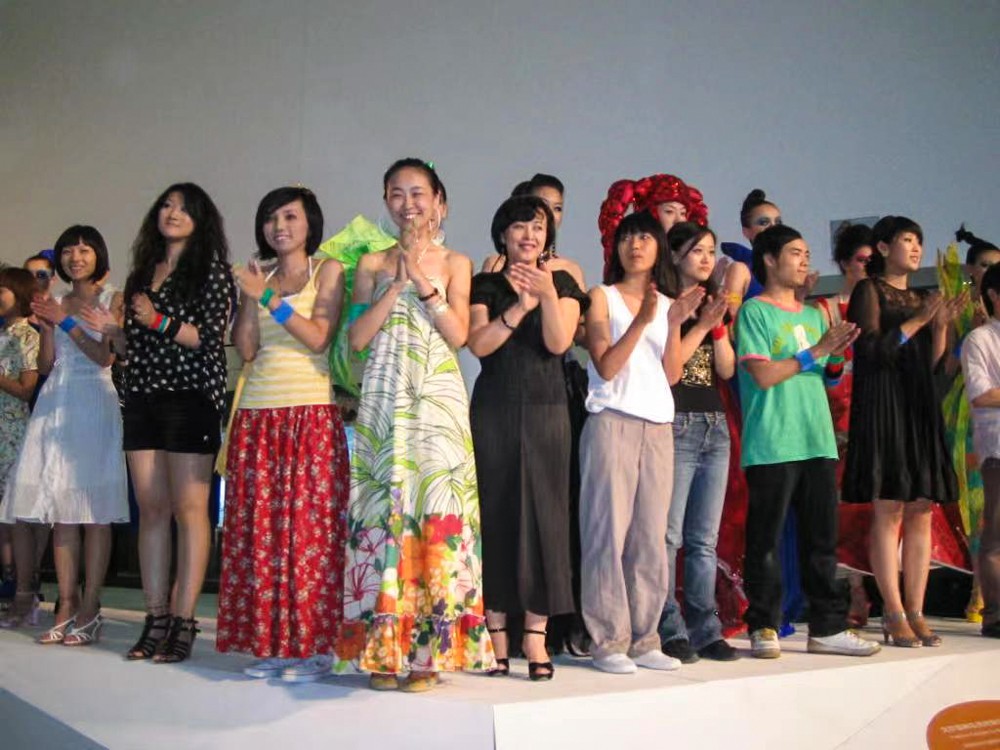
At the Opening Ceremony of National Art & Design Exhibition for 2008 Beijing Olympics, teachers and students presented their works around the Olympic elements.
One branch of contemporary art is Fashion Art, in which practicality does not need to be considered, and there is no boundary between the wearable and the unwearable in the category of art. This concept has the same origin as the occurrence of American contemporary art, and the works and concepts of American contemporary artists such as Pollock and Andy Warhol have a great influence on fashion design and fashion art. At the same time, the clothing industry is also admiring and appreciating unique handmade clothing, believing that such clothing is full of the emotions of the creator, this has a “temperature” as well as a “soul” like art. At that time, open minds and bold acts of rebellion influenced by some artists called for the works displayed on the walls of the museum to be taken down, to get closer to life, to make these arts wearable, to create to wear, and to come up with a term “art to wear”. There are many artists involved, especially female artists, who integrate traditional American female crafts such as patchwork quilts, crochet, weaving and other technical means into their works, at this time the material and technical techniques of the works have begun to change accordingly, but also with African sculpture, Japanese kimonos, lacquerware, screens, ukiyo-e, etc., those that can be worn and hung on the wall have sprung up.
As this vein expanded, the artists participated in “Clothing as Form (1966)” (Dress Up!) and “Dress Up! Make It! Wear It! Share It!” (1973), “Clothing to Be Seen”(1974), “Art for Wearing” (1979) (San Francisco Museum of Modern Art), “Wearable Art” (1979) (KEN Phillips Gallery, Denver), “Art as Clothing” (1979), Spirit Crafts Gallery, Scottsdale, AZ and many other large and small exhibitions. Finally, with governmental support, an exhibition titled Art to wear: New American Handmade Clothing traveled from the United States around the world and had a major impact on the entire field of fashion design.


Lyu Yue, “The Harmony Between Yin and Yang”, 2006; The metal is used as a raw material, which is connected by wire, its dimension is variable.


Lyu Yue, “Red Woman”, 2013; Silk satin, brocade, nylon organza, fresh roses, Dimension variable
In 1969, Jean Williams Cacicedo, an undergraduate student at the Pratt Institute of Art, learned to use crochet from older members of her family and gradually developed a weaving group in the school’s dormitory. Jean Williams Cacicedo led her classmates, Janet Lipkin, Marika Contompasis who applied weaving techniques to the creation of artworks. What is even more surprising is that when the students’ graduation works made with these unusual materials are recognized by the school, they finally graduate and obtain a degree. This is also a landmark event in the history of fashion design. The 2019 exhibition “Off the Wall: America Art to Wear,” at the Philadelphia Museum of Art, featured most of the work of the time, and it makes sense now.
At present, there are two forces that we pay more attention to: one is the Fashion Art Biennale held by the Korean Fashion Art Association, and the other is the WOW Competition in Oceania, which has received great attention because of the American tour, and in the same year, a Korean scholar studying in the United States exhibited the traditional Korean fashion art in the form of patchwork in her solo exhibition, which was applauded widely. This was followed by group exhibitions of Korean artists, the establishment of associations, and the holding of international exhibitions every year (called “Biennale” held in Korea, “overseas exhibition” held outside Korea). The America tour influenced New Zealand, developing a global creative competition show in Oceania. Both of them are complements to “art to wear.” Later, it gradually evolved into the art of clothing that could not be worn, especially in Japan, Issey Miyake and Yohji Yamamoto both designed fashion art works that could not be worn, and Yohji Yamamoto once made a set of clothes out of wooden planks that could only be worn on the couture show. At this time, the concept of “fashion art” has been expanded, “art to wear” and “unavailable art” have been included, and the concept of fashion art is more accurate. This is also the research I am doing with my postgraduates and doctoral candidates.
All designs are composed of functional and artistic parts, and there is no aesthetic zeroing design. When aesthetics and design occupy each half of the whole, the clothes designed are fashion, and when aesthetics are emphasized, functionality is weakened. Extreme examples are the costumes of celebrities as they walk on the red carpet, focusing on the dazzling moments when the stars appear. There is also a category that ignores functionality and is only artistry. Clothes are the closest to people, even if people are emptied, clothes have their own language, such as Sui Jianguo’s work “Mao suite” in which he showed the Zhongshan suit, and Boyce cut the felt that saved his life on the battlefield into a suit, and they did not even have buttons. In Beuys’ eyes, the garment is symbolic, and he sees it as the shell of life. Interestingly, Beuys’ felt suit is sold at many fairs and is selling well. At this time, it became a work of art and met the demand for art consumption.
Speaking of which, the meaning of the clothes that cannot be worn is already clear, it is an expression of the idea. Especially on the couture show, each show has its own concept and theme, artistic clothes are mainly emphasized, and functional clothes are for sale. This is also a measure for brands to increase the gold content, highlighting that creativity is the embodiment of the added value of clothing. Why many people chase luxury, in fact, the pursuit is its aesthetics and artistry. It’s the same as some people who collect different styles of cups and some limited-edition sneakers, and the masses are paying for human creativity.
CAFA ART INFO: From the time you entered China’s first Fashion Art Department in 1984 and you graduated and started to work to today, it can be said that you have witnessed the development of the entire fashion industry in China, and I would like to ask you to briefly talk about the development process of China’s fashion industry and the future development.
Lyu Yue: The Chinese fashion industry has gone through the initial period to learn from the West, then participate in fashion activities in the Western world, and then return from the West to focus on the power of China. It can be seen in the literature of the exhibition “Beyond Seeing.” This is also the tone that since the reform and opening up, China has begun to learn from the West, to synchronize with the international and finally participate in and even lead, and the garment industry is no exception. Many things are slowly changing, on the one hand, we are involved in international affairs, for example, international clothing brands, fashion magazines, etc. have landed in China, VOGUE, BAZAAR and other influential paper media in the field of fashion to the launching of Chinese versions, they see China’s market demand, or see that China has the power to echo them. In recent years, some Western brands have closed and print media have been suspended, while China has constantly seen the rise of new things and begun to take the lead in some areas, such as our self-developed and designed spacesuits, which shows that China’s fashion industry has a leading edge in some aspects.

Lyu Yue, “Madama Butterfly”, 2016-2020, Blue printed cloth, variable size, it was collected by the China Silk Museum.

Lyu Yue, “Cloud Dress”, 2019, transparent yarn, silk, ready-to-wear size
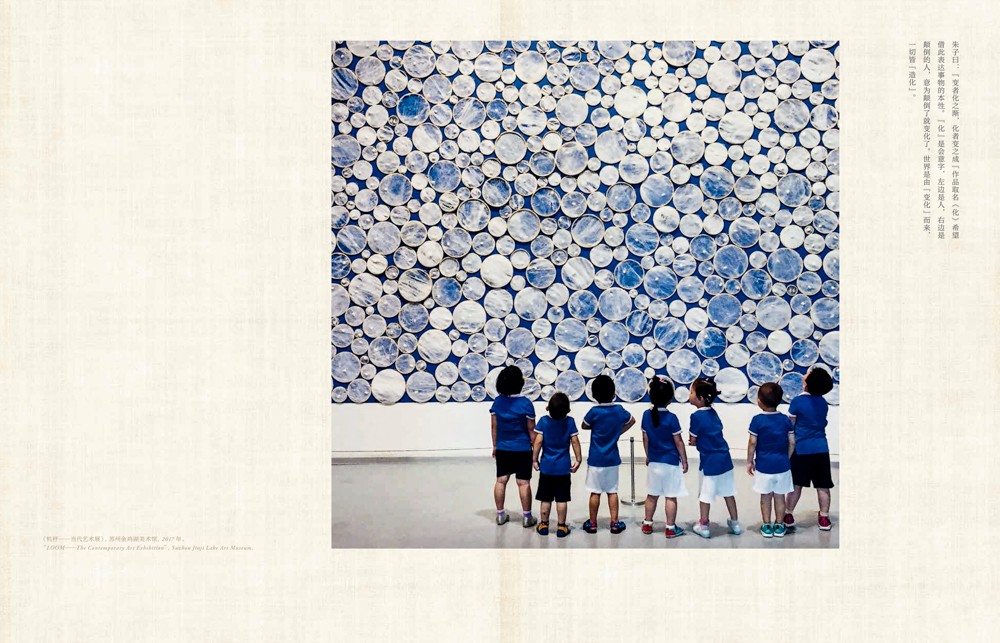
Lyu Yue, “Transformation”, 2017, silk, cocoon, bamboo embroidery, glow, butterfly specimens, variable size
But even so, I think China’s fashion industry is still in development, with a dynamic look at the problem, this is what I have always insisted on, no matter what happens, there will be updates and changes in the future. This also confirms the old saying that “what remains unchanged is a change", and I once created the work “Transformation” with embroidered bandages, silk, silkworm cocoons and butterfly specimens, which reflected my thoughts on it.
Text (CN) by Yang Zhonghui, ed. and trans. by Sue/CAFA ART INFO
Note:
[1] The press release for “Beyond Seeing: From the Brother Cup to Hempel Award”: China International Young Fashion Designers Contest 30 Years 1993-2022.




























